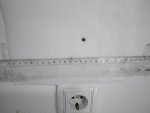- Joined
- Jul 10, 2015
- Messages
- 13,083
- Points
- 113
How hard are you driving your 08 block ? That is what is the output from your power supply going into the 8 diodes ?
I am curious how many watts are you putting through the PBS cube from techhood because I did not think they would take tens of watts ?
Are you still planning to do this with a nubm44 block from a V1 using G2's ? If so I would be interested to know how much a PBS can take.
--edit--
I see 1.99a on your power supply display, so if you are driving two strings of 4 in series parallel @ 15v and 2a then each diode would be getting 1a making 1.1w at each Gball for a total of 8.8w raw for the block and maybe 7w after losses in your final beam ? or are you driving them all in series at 32v and 2a ?
I have under driven GBalls before to get a smaller/tighter beam but I have not attempted to knife edge from GBall intact diodes, it's cool to see you have made it work but I am curious about your final beams wattage, can you share a result please ?
I am curious how many watts are you putting through the PBS cube from techhood because I did not think they would take tens of watts ?
Are you still planning to do this with a nubm44 block from a V1 using G2's ? If so I would be interested to know how much a PBS can take.
--edit--
I see 1.99a on your power supply display, so if you are driving two strings of 4 in series parallel @ 15v and 2a then each diode would be getting 1a making 1.1w at each Gball for a total of 8.8w raw for the block and maybe 7w after losses in your final beam ? or are you driving them all in series at 32v and 2a ?
I have under driven GBalls before to get a smaller/tighter beam but I have not attempted to knife edge from GBall intact diodes, it's cool to see you have made it work but I am curious about your final beams wattage, can you share a result please ?
Last edited:











